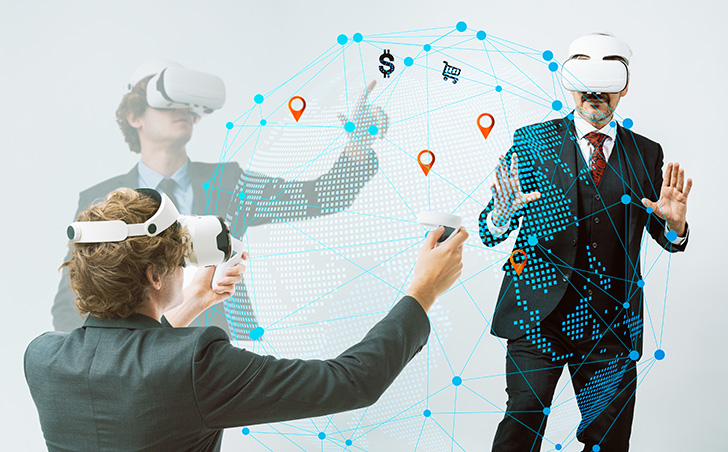
Metaverse and Risk Management by Professor Jean-Paul Louisot
The article has been read 424 times, since it was published on 10/06/2022 at 07:15:19 (Length: 6043 characters)
“We are convinced that the metaverse will succeed the mobile internet. We will be able to feel the present, as if we are together physically, no matter how far apart we are. (Mark Zuckerberg)
Who hasn’t come across the term “metaverse” in the headlines lately, but what is it and why is it important to all managers? Here is an explanation of how the digital experience has evolved into something that blurs the lines between digital and physical! Seriously, what does “Metavers” mean?
To understand the ambiguity and complexity of the term “metaverse,” here is an exercise in which you mentally replace the expression “metaverse” in a sentence with “cyberspace.”
Nine times out of ten, the meaning will not change. This is because the term does not really refer to any particular type of technology, but rather to a general (and often speculative) change in the way we interact with technology. And it is entirely possible that the term itself will eventually become obsolete, even if the specific technology it once described becomes prevalent.
This is why the words ‘mysterious’ and ‘complex’ in reference to the term ‘metaverse’ are an extreme euphemism in relation to ideology because it simply does not exist yet. When Mark Zuckerberg told the world and announced that Facebook would be rebranded to “Meta” in October 2021, “Metavers” became the buzzword circulating around the world, and many observers remained in a state of ambiguity about its concept and future technological impact.
Tech companies started investing their capital and efforts to create the metaverse; The increasing intensity and speed of these investments is a sign of great things to come. Even those who are not enthusiastic about understanding this concept should pay attention to the term and try to understand why tech giants such as Facebook, Google and Microsoft have invested so much in its development.
The coining of the term “Metavers” is attributed to author Neil Stevenson in his 1992 science fiction novel “Snow Crash.” The novel envisioned the next iteration of the Internet where photorealistic avatars connect to each other through virtual reality environments and realistic 3D buildings.
Since then, technological advances have enabled the development of the metaverse with a mix of computers, technologies, and wearable machines, such as virtual reality headsets, augmented reality glasses, motion sensors, and game consoles where users can “live” in a digital world.
Today’s Internet experience is a 2D experience where everything is scrolled and browsed on the screen. On the other hand, the metaverse is 3D, which allows the individual to “walk” through the two intertwined worlds by means of connected glasses or headphones resulting in building or participating in any desired world in the world. Digital.
In simpler terms, instead of browsing a clothing store or online store, the website is transformed into a 3D shopping mall or building where users can interact as in-game characters or avatars.
changed the game. The metaverse does not necessarily refer to a specific type of technology, but rather to the changing interaction of actors with it to make their virtual space seamlessly integrated with reality. Michele Cortez explains that the metaverse is essentially a “spectral layer above our existence”. It is represented by avatar interactions and built experiences, ultimately changing how players interact online, how coding is adopted, and how brands are advertised, all while providing a very real alternative world where people can coexist.
A concept embraced by technology enthusiasts. But as much as it satisfies the desire for a decentralized virtual world and provides a place in line with the physical world, the metaverse is now beginning to penetrate the public landscape. Virtual experiences have increased exponentially with millions of people immersing hour after hour in a digital avatar in virtual social spaces such as Fortnite and Roblox or digital TNT and cryptocurrency.
Victoria Petrock said: “It’s the next evolution of connectivity as all of these things begin to come together in a seamless double world, so live your virtual life the way you live your life.”
Core Metaverse, also known as Web 3.0, is the evolution and next generation of the internet today, including how users control their online identities and digital assets through blockchain and cryptocurrencies.
“The technology will be so good that it will be very difficult for people to view or consume something that was not designed for them. (Eric Schmidt, President of Google)
What is web 3.0?
“metaverse is here, and it’s changing not only the way we see the world, but the way we participate in it – from the factory floor to the boardroom. (Satya Nadella, CEO, Microsoft)
To understand Web 3.0, it is important…. Read more in Issue 707 of Risk Asor Abdo: Press here
Annual subscription to Risk Asor Abdo magazine: Press here
————-

“Certified gamer. Problem solver. Internet enthusiast. Twitter scholar. Infuriatingly humble alcohol geek. Tv guru.”





